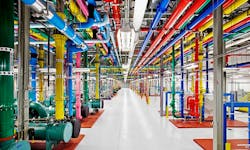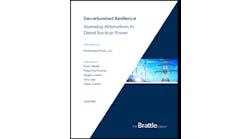Google is working on new cooling technologies that could dramatically slash the use of water in its data center operations. The initiative is part of the company's multi-faceted commitment to "climate-conscious" data center cooling to reduce its impact on water in the communities where it operates.
The company has also released details of the water used by each of its data center campuses for the first time and is working with local communities on responsible use of water resources and investing in watershed replenishment.
Google has always been a leading innovator in data center efficiency, applying new technologies and designs to help servers run faster, cheaper and cleaner. That will again be the case in the climate-conscious cooling initiative, the company says, although it's not ready to unveil its new cooling tech.
"We are currently developing new cooling solutions that leverage low-water alternatives, and target data center water use reduction by as much as 50% without making meaningful impacts on the world-class energy efficiency that we've been able to achieve," said Ben Townsend, Head of Infrastructure Water Strategy at Google. "These alternative cooling solutions that we're investigating right now are working through the early pilot stages."
Providing Details on Water Usage
Google announced its commitment to climate-conscious cooling in November, which featured the release of water usage data that it previously fought to keep private. The company said it consumed about 4.3 billion gallons of water across its global data center network.
"Our Climate-Conscious Cooling strategy is all about focusing on net climate impact reduction, but also being extremely transparent on how and why we use water," said Townsend, who said the consumption figure "is a number that should be taken seriously. Without context, it can be a scary number to the average consumer. But the translation is that 4.3 billion gallons a year is roughly the same amount of water that 29 golf courses use in the American Southwest."
That comparison underscores the value proposition of data center services, which became clear during the COVID-19 pandemic when Internet services became a lifeline to a world in lockdown. For additional context, there are more than 11,000 golf courses in the U.S., according the Bureau of Labor Statistics.
Townsend says that when it comes to reducing climate impact, using water rather than just air cooling offers advantages.
"We were able to apply water-based cooling technology that reduced our annual energy and carbon emissions by 10%, or roughly 300 kilotons of CO2, which is around the same annual emissions of 64,000 passenger vehicles," said Townsend.
The Google data show a wide range of water usage across its operations, reflecting differences in climate and the scope of its infrastructure in that location. Here's the largest campuses, in terms of water usage:
- Council Bluffs, Iowa: 1.1 billion gallons
- Mayes County, Oklahoma: 863 million gallons
- Berkeley County, South Carolina: 541 million gallons
- The Dalles, Oregon: 358 million gallons
- Lenoir, North Carolina: 352 million gallons
Hyperscale Operators Face Scrutiny
Google's new water new strategy represents a shift, as heightened awareness of water constraints raises the bar for hyperscale computing specialists and data center developers. As the data center industry has confronted its environmental responsibilities, water has too often been a secondary concern compared to electricity, a function of power’s more direct impact on carbon footprint.
"Our historic decision making has been putting energy efficiency front and center as sort of our North Star when it comes to data center sustainability," said Townsend. "In light of the clear connection between data center energy consumption, and carbon emissions that are perpetuating climate change, we're really proud of like the industry leading PUEs (Power Usage Effectiveness) that we've been able to achieve."
Data center builders have used a variety of techniques to reduce their water use and community impact, including use of fresh air cooling and other low-impact cooling, and the use of recycled “grey” water systems, including municipal systems in places like Ashburn and San Antonio, and company-built water treatment plants (including a Microsoft site in Quincy, Washington and Google campuses in Atlanta and Belgium). Immersion cooling technologies also offer the ability to use less water than some other approaches to cooling.
The leading hyperscale operators have also made reduced water use a priority in the design and operations of their data center operations, as reflected in recent announcements:
- In December 2021, Microsoft pledged to reduce the use of water in its data centers by 95 percent by 2024, partly by operating its server rooms at warmer temperatures, which will enable it to dramatically reduce its water use and environmental impact. Microsoft also plans to boost its use of liquid immersion cooling as it optimizes its cloud infrastructure to meet its commitment to be carbon-negative by 2030.
- Last October, Meta followed suit and said it plans to slash the water use of its data centers by running its servers in warmer and drier environments, including operating its data halls at 90 degrees,. The company has already pushed humidity levels as low as 13 percent in server rooms across its global fleet of data centers, which will save millions of gallons of water annually.
- In November, Google announced its Climate-Conscious Data Center Cooling Commitment.
- A week later, Amazon Web Services said it intends to be water-positive by 2030, returning more water to communities than it uses in its direct operations. AWS said it invests in on-site water-treatment systems that allow it to reuse water multiple times, minimizing water consumed for cooling. AWS also highlighted its use of recycled water, which preserves valuable drinking water for communities, but is only available where local utilities have created systems offering recycled water to customers.
The Three Pillars of Google's Strategy
Google has defined three "pillars "for its strategy:
- Working with communities to fully understand available water resources and use them responsibly. This includes disclosure of Google's water use in each community.
- Seeking to replenish local water resources, restoring 120% of the water that Google uses in its operations. Watersheds " haven't gotten the attention that they deserve," said Townsend. "So we want to come up with strategic investments, in collaboration with our communities, so that we solve the tough problems. That's an important part of environmental stewardship."
- Google also seeks to use technology, both in the cooling designs in its data centers, and data tools and analytics to help communities track their water resources using a science-based approach.
On the cooling technology front, Townsend says Google is investing in developing technologies "that we hope can shatter this ceiling on energy efficiency that we are seeing with air cooled solutions right now. Air- cooled data centers are just hitting this efficiency ceiling, that we really hope that we can break through research and development, as well as meaningful partnerships with cooling technology companies and potentially other hyperscalers."
Balancing Efficiency, Water and Carbon
Data center cooling can be complicated, and requires balancing competing goals in water conservation and carbon reduction.
"What we're continuing to see is that from a cooling technology and efficiency perspective, water is an extremely important and powerful resource in reducing energy consumption and it's related carbon emissions," said Townsend. ""How are we being extremely transparent with our communities, so that they understand how and why we're using water and forming meaningful relationships with the water purveyors in these communities with a foundation being not just transparency, but also sustainability and water stewardship?"
The transparency piece is new. Google previously fought to keep its water use at the facility level under wraps, arguing that it was a trade secret. It stuck to that policy through a lengthy public controversy about its use of aquifers in South Carolina. Last year, The Oregonian sued the city of The Dalles seeking to obtain records of Google's water use, which the city refused to disclose, citing Google's position that the data was a trade secret. The lawsuit was settled in December following Google's decision to release site-specific information about its water use.
"We’ve long considered site-specific water usage to be a trade secret," said Townsend. "It was really for reasons that had little to do with water. We started sharing aggregate water usage in our environmental report in 2017, but not breaking it down on a site-by-site basis was about releasing site-level compute indicators. As we were growing our investment and our compute pool, we wanted to be careful about sending signals to other players in the space or customers on how we were growing, where and why.
"It created, I believe, a misperception about why we weren’t talking about the water footprint," said Townsend. "But as we diversified our portfolio in terms of locations and cooling technology, water consumption is less linked to compute capacity."
Transparency Enables Collaboration
Perhaps more importantly, that level of secrecy loomed as a barrier to collaboration.
"We view transparency as a very important starting point to the company-wide commitment we made in 2021 around water stewardship," said Townsend. 'We’ve got this cooling challenge we want to solve, and we want to be a leader and collaborate with others, and the best way to start an honest conversation is with honesty and transparency. We have to provide details on our footprint, but also provide context about what it means."
The need to step up cloud computing' s response to climate change is being felt across the data center industry, including in collaborations like the Infrastructure Masons Climate Accord.
"If we don’t actively drive this change internally, as citizens of earth and citizens of these companies, it’s not going to happen," said Townsend. "There are a lot of people in the industry who are collectively saying ‘we’ve got to talk about this stuff. Where are we going? We all live on this planet together, let’s solve this together."






